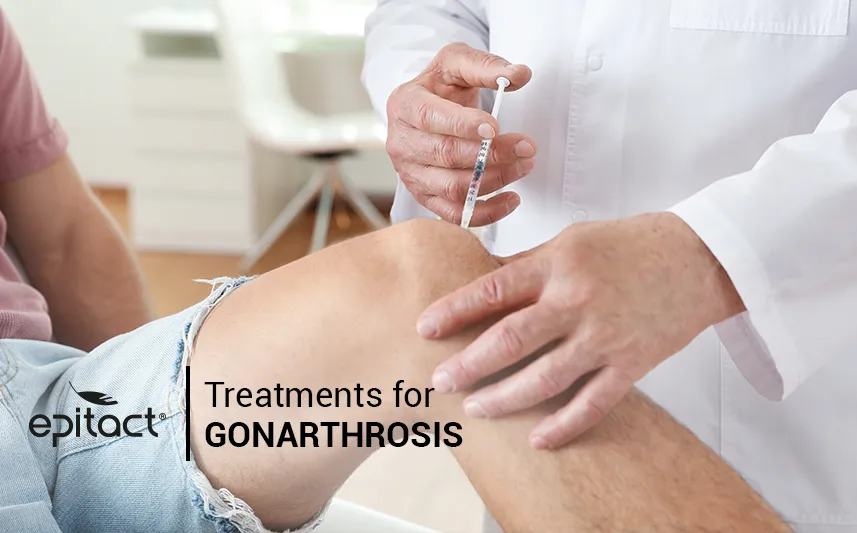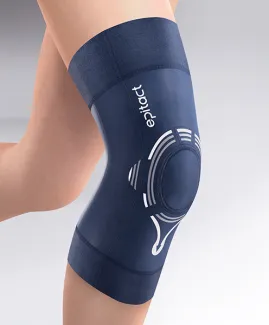
Treating arthritic knees is not that simple because it is a condition that worsens over time. Arthritis in the knee is one of the most frequent causes of knee joint pain. The symptoms, which are intermittent and localised in the beginning, can become diffuse and constant, even at rest. It leads to swelling, pain and stiffness during movements.
Even if there is no cure, there are many treatments for arthritis in the knee to relieve the pain and stay active. From support devices to physical therapies and surgery, discover the main treatment for knee arthritis, also called knee osteoarthritis.
What is arthritis in knee or knee arthritis?
Knee arthritis is a common joint condition caused by cartilage wear. It is also called knee osteoarthritis, which is the most common type of arthritis.
Before getting a treatment for arthritis in the knee, it is necessary to establish the diagnosis to know which part of your knee is affected. Indeed, the knee is a tripartite joint that includes the thigh bone, the shin bone and the kneecap. So, osteoarthritis can affect the patellofemoral joint (between the kneecap and femur), the tibiofemoral joint (between the tibia and femur) or both.
According to the European League Against Rheumatism’s recommendations (EULAR), the diagnosis precisely determines the most affected area thanks to radiological examination. This examination can be prescribed by your sports physician, general practitioner or orthopaedic surgeon.
Arthritis in the knee: treatment and solutions by EPITACT®
The affected joint and the stage of the condition determine what is the most appropriate treatment for osteoarthritis in the knee. Each case is unique but the early stages are addressed with medical treatments unlike advanced stages that require more invasive treatments, namely surgery.
Medical treatments for arthritis in the knee
The first objective of treatment of osteoarthritis in the knee is to reduce the symptoms, specifically the pain.
Treating arthritic knees with medications
Oral or topical analgesics (e.g. paracetamol) or non-steroidal anti-inflammatory drugs (NSAIDs) can help relieve symptoms of knee arthritis.
You can also be prescribed corticosteroids or hyaluronic acid injections to alleviate your pain.
Knee support
Wearing a specific knee support brace is specially advocated as conservative treatment of knee arthritis. The EPITACT® PHYSIOstrap™ MEDICAL knee brace* has been created to reduce pain related to patellofemoral pain syndrome or patellofemoral osteoarthritis.
A tendon made of silicone and a technical fabric surrounds the kneecap to avoid lateral deviations of the knee during movements. The ultra-thin fabric doesn't apply additional pressure on the knee. This fabric is combined with two silicone strips: one around the calf, the other around the thigh. This design guarantees a good holding all day long. This knee support for arthritis is also available in sport version*.
Orthopaedic treatment for osteoarthritis in the knee
Wearing orthopaedic insoles can also relieve the pain by changing the body weight distribution.
Therapy
In addition, your general practitioner can prescribe you some physiotherapy sessions to complete your treatment for arthritis in the knee. The nature, duration and intensity of the exercises will be adapted to you to relax, stretch and strengthen your muscles.
Lifestyle changes: last arthritis in the knee treatment option
Being overweight is a significant risk factor for knee osteoarthritis, so losing weight is one of the first things you can do. If it is your case, you can have a nutritional follow-up to improve your BMI (Body Mass Index), thereby reducing the pressure on your joints and providing pain relief.
Surgical treatments for osteoarthritis in the knee
If medical treatments for arthritis in the knee are insufficient to slow down the progression of the disease, knee replacement surgery can be considered. This type of surgery consists in replacing the damaged knee joint with an implant. Except for some associated diseases, there are no contraindications for this procedure. However, like any surgical procedure, there are some risks such as those related to anaesthesia.
Physiotherapy sessions may be sufficient and avoid a stay in a rehabilitation centre.
Depending on the degree of the joint deterioration, the knee prosthesis can be partial or total. Partial prosthesis consists in substituting the most damaged part of the joint. It means that the medial or lateral tibiofemoral compartment or the patellofemoral compartment can be replaced.
This surgical treatment for arthritis in the knee can be performed under general, spinal or regional anaesthesia.
The incision is made on the knee, along the patellar tendon.
The prosthesis is implanted with impaction thanks to a specific cement that contains calcium and favours bone regrowth on the prosthesis for a definitive fixation.
Finally, a drain is placed to remove the existing haematoma. To limit the risk of phlebitis, compression stocking and anticoagulants can be prescribed. Rehabilitation allows more flexibility and strength in order to progressively resume normal activities and improve your life comfort.
The treatment for arthritis in the knee depends on many factors such as the affected joint compartment, the pain experienced or the discomfort caused for example. Either medical or surgical, the knee arthritis treatments should be meticulously followed to hope for the best results possible.
Discover more details about treating arthritic knees with surgery and the main causes of this disease.
*These solutions are class I medical devices that bear the CE marking under this regulation. Carefully read the instructions before use. Manufacturer: Millet Innovation. 08/2021
For more details about this general and simplified approach, here are further sources:
https://www.arthrolink.com/fr/dossiers-arthrose/tous-les-dossiers/arthrose-quand-operer
https://www.eular.org/search.cfm https://public.larhumatologie.fr/grandes-maladies/arthrose/comment-se-traite-aujourdhui-larthrose
 Pharmacie
Pharmacie
